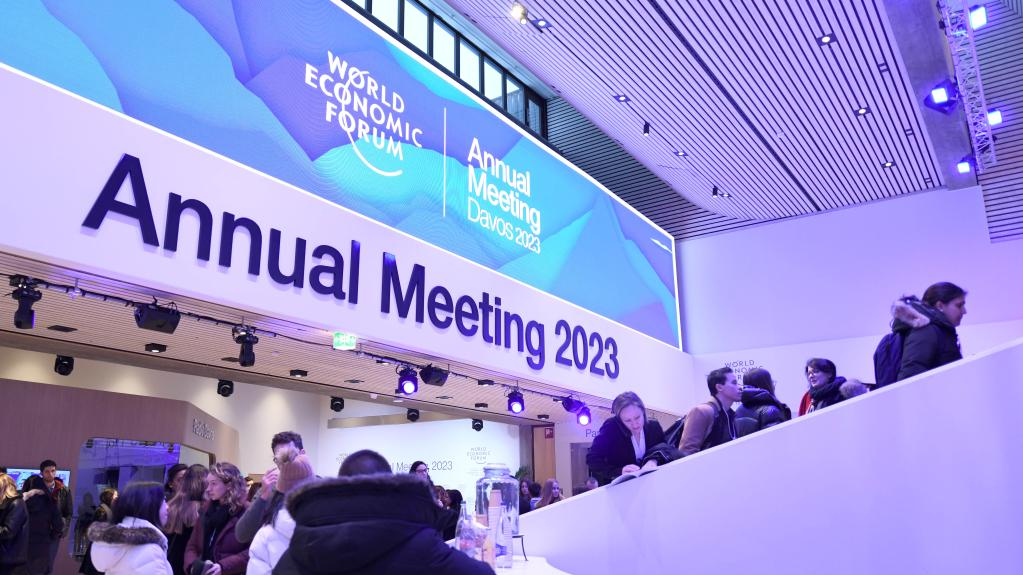
People communicate with each other at the Congress Center for the World Economic Forum Annual Meeting 2023 in Davos, Switzerland, January 15, 2023. /Xinhua
People communicate with each other at the Congress Center for the World Economic Forum Annual Meeting 2023 in Davos, Switzerland, January 15, 2023. /Xinhua
Editor's note: Francisco Betti is the head of Shaping the Future of Advanced Manufacturing and Value Chains of the World Economic Forum. Ian Cronin is the community curator of Shaping the Future of Advanced Manufacturing and Value Chains of the World Economic Forum. Maria Basso is the platform curator of Shaping the Future of Advanced Manufacturing and Value Chains of the World Economic Forum. The article reflects the authors' opinions and not necessarily the views of CGTN.
As the calendar clicks over to 2023, however, we are seeing that the ability of industrial players to realize the potential offered by the Fourth Industrial Revolution will depend on how effectively they can embrace three core tenets: a new long-term focus on resilience as the primary driver of productivity, growth, sustainability and inclusivity; technology adoption and workforce empowerment at scale; ecosystem collaborations that unlock new avenues for capturing and delivering value to a much broader stakeholder community.
Resilience is the future
Manufacturing and supply chains are the beating heart and blood of industrial societies, so we need them healthy and resilient to tackle the challenges we face today – including poverty, the climate crisis, and current geopolitical tensions. Resiliency is the new foundation for the future and health of our industrial systems, which can then enable growth, sustainability and inclusivity. If we want to fix inequality and sustainability, we need to fix manufacturing's ability to be resilient and contribute to the wellbeing of our economies.
Central to any industry's ability to manage shocks, is the structure of its supply chains. While reactive calls for protectionist policies continue to rise, value chains are and will likely remain global, but this doesn't mean they won't change. We are, in fact, already seeing a restructuring of these global value chains as companies seek to find a new balance between manufacturing in the places where they can produce the highest quality at the lowest price, with the risks that come from being over-reliant on single supplier sources.
This rebalancing won't happen in one massive shift, but rather in the form of degree-shifts as global companies reinforce their local manufacturing networks. Companies will find a new way to leverage both macro supply chains that allow for all the benefits that come with scale and the need to invest in local partnerships that allow for regionalization of supply to enhance resilience, as well as the ability to meet consumer demand for more personalized product offerings.
As manufacturers look to make these shifts, the long-term ability of these efforts to truly drive more resilient production systems will be equally dependent on public sector leaders. In parallel to these private sector actions, governments must rethink their industrial strategies to bring their local manufacturing sectors back to life and ensure the workforce is prepared to meet the needs of companies hoping to expand their local capacity.
Beyond this restructuring, future resilience will also require companies to have a better understanding of the global trends that may disrupt their operations, and how to best navigation those disruptions. To this end, the World Economic Forum has developed the Global Value Chains Barometer, a new tool to monitor on a quarterly basis disruptions affecting global value chains along the three mega-trends – climate change, geopolitical tensions and emerging technologies. The barometer also provides an outlook on the expected implications for operations and how to be better prepared for the key trends that are redefining global value chains.
From speed to scale: the next step in technology adoption and workforce empowerment
Adopting technologies has always been a tricky balancing act for manufacturers. They must constantly weigh the potential that could be unlocked through current technology innovations against the resulting need to upskill their workforce and put it at the center of the transformation, all while being prepared for the innovations of tomorrow.
While most manufacturers are still focused on looking at specific use cases and how they might roll them out as quickly as possible in a single location, we are seeing some manufacturers who seem to have been reading ahead to a new phase of the Fourth Industrial Revolution. Over the last four years, the World Economic Forum's Global Lighthouse Network has sought to identify the most advanced manufacturing facilities and value chains in the world – there are now 132 lighthouses – including 13 sustainability lighthouses.

A ship unloading cargo at the ore wharf in Caofeidian Port area, Tangshan Port, north China's Hebei Province, July 18, 2022. /Xinhua
A ship unloading cargo at the ore wharf in Caofeidian Port area, Tangshan Port, north China's Hebei Province, July 18, 2022. /Xinhua
Of those lighthouses, we are beginning to see front-runners that have not only one, but several lighthouses in this network as they recognize the multiplier effect that accompanies digital transformation of their facilities around the world. Johnson & Johnson, for example, has 10 lighthouses in eight different countries. P&G and Unilever each have six lighthouses in the network spanning an additional eight countries. These leading lighthouses also seem to be drawn to regions that encourage the rapid transformation of industrial sectors. China, for example, has 46 lighthouses, nearly 35 percent of all lighthouses recognized globally.
As global manufacturers embark on the next phases of their digital transformation journeys, it is critical that they, too, embrace the potential of this multiplier and aim not only to transform a single site, but rather multiple nodes and functions across their production ecosystem.
Collaborations of the future
As the world becomes increasingly digitally interconnected, the ability to thrive in the future will be intrinsically linked to a company's ability to collaborate in new and more effective ways across three critical stakeholder groups: their core supply chain partners; their broader industrial ecosystem, including supply chain partners, but also competitors and complementary industry players; public sector stakeholders.
Most companies, even those who have been successful at scaling new technologies across multiple production sites around the world, still struggle to effectively drive collaborative innovation and share relevant data with their supply chain partners. We are however seeing new collaborations forming that enable to drive collective action on shared ambitions like achieving net zero value chains. One such example is the Estainium Association, that, among other things, is helping to build an infrastructure that would allow companies to securely share carbon data with supply chain partners without putting their intellectual property at risk.
Beyond collaborating only with existing supply chain partners, we are also seeing that companies who are concretely demonstrating the positive potential of the Fourth Industrial revolution are building partnerships with their broader industrial ecosystem. A clear example can be seen in a recent collaboration between the World Economic Forum, Ralph Lauren, Vestiaire Collective, Digimarc Corporation and Bain & Company wherein the group launched a pilot to demonstrate how emerging technologies can deliver value far beyond their originally intended scope – specifically, the pilot showed how digital traceability technologies originally used for supply chain management could be extended to resale marketplaces to drive greater circularity in the fashion sector.
Finally, if the last three years have shown the world anything, it is that public-private collaboration will be key to the future success of the world's industrial economy. This does not mean, however, doing more of the same. Instead, we need to find new frameworks for public-private collaboration as well as gain a better understanding of the industrial policies and strategies that will ensure a more productive, sustainable and inclusive future for all.
To this end, following a call from ministers and chief executive officers during the World Economic Forum's Annual Meeting 2022 to build a global network of centers focused on shaping the global agenda on the future of production, while contributing towards strengthening the competitiveness regional manufacturing sectors, we have built on the forum's existing network of 15 centers for the Fourth Industrial Revolution to launch the U.S. Center for Advanced Manufacturing. The hope is that this will be the first of many such national centers focused on advanced manufacturing that better advance national industrial interests, while creating a new mechanism for global collaboration.
In addition, while it is clear that no industrial policy or strategy can be simply copied and pasted across global regions, there is a recognition that nations need a better understanding of how others are looking at their industrial development plans, as well as a common set of tools that policy-makers can use to understand the most effective industrial strategies for their specific needs. Public and private sector industrial stakeholders must work together to foster a continuous collaboration mechanism to share best practices, discuss challenges and find partners to catalyze efforts to create stronger and more resilient manufacturing sectors.
We look forward to continuing to work with the global manufacturing community to support the transformation of production systems and value chains for growth, resilience, sustainability and inclusivity.
(If you want to contribute and have specific expertise, please contact us at opinions@cgtn.com. Follow @thouse_opinions on Twitter to discover the latest commentaries in the CGTN Opinion Section.)